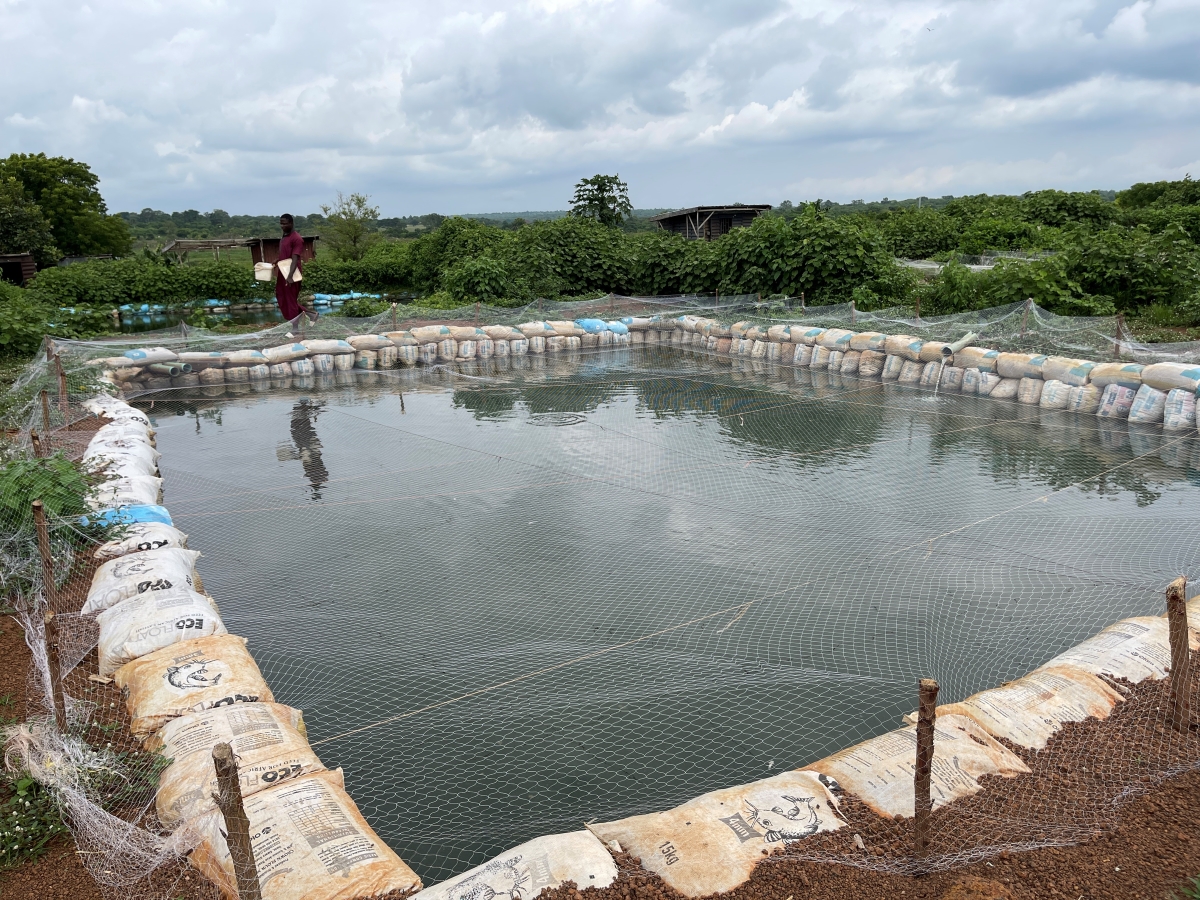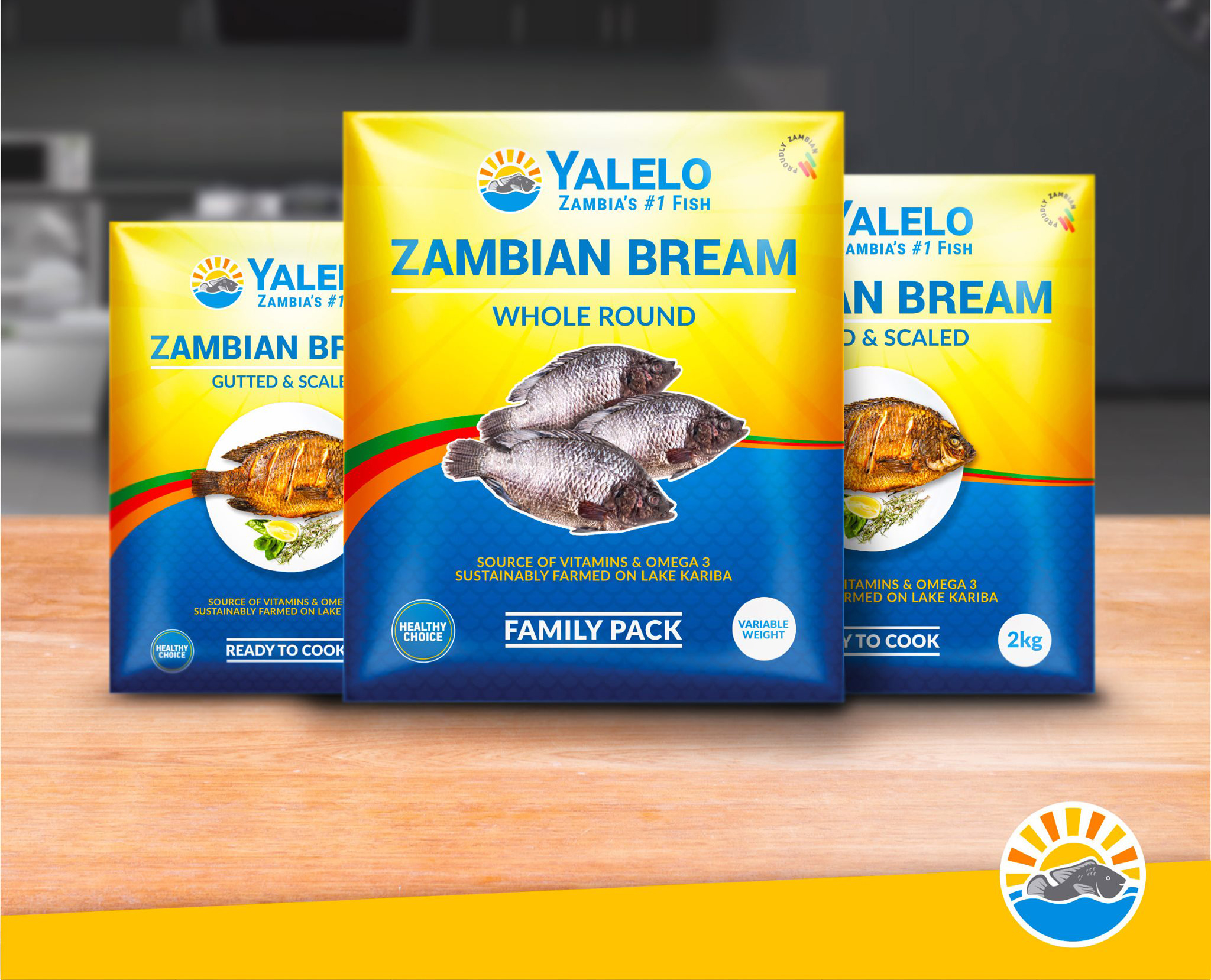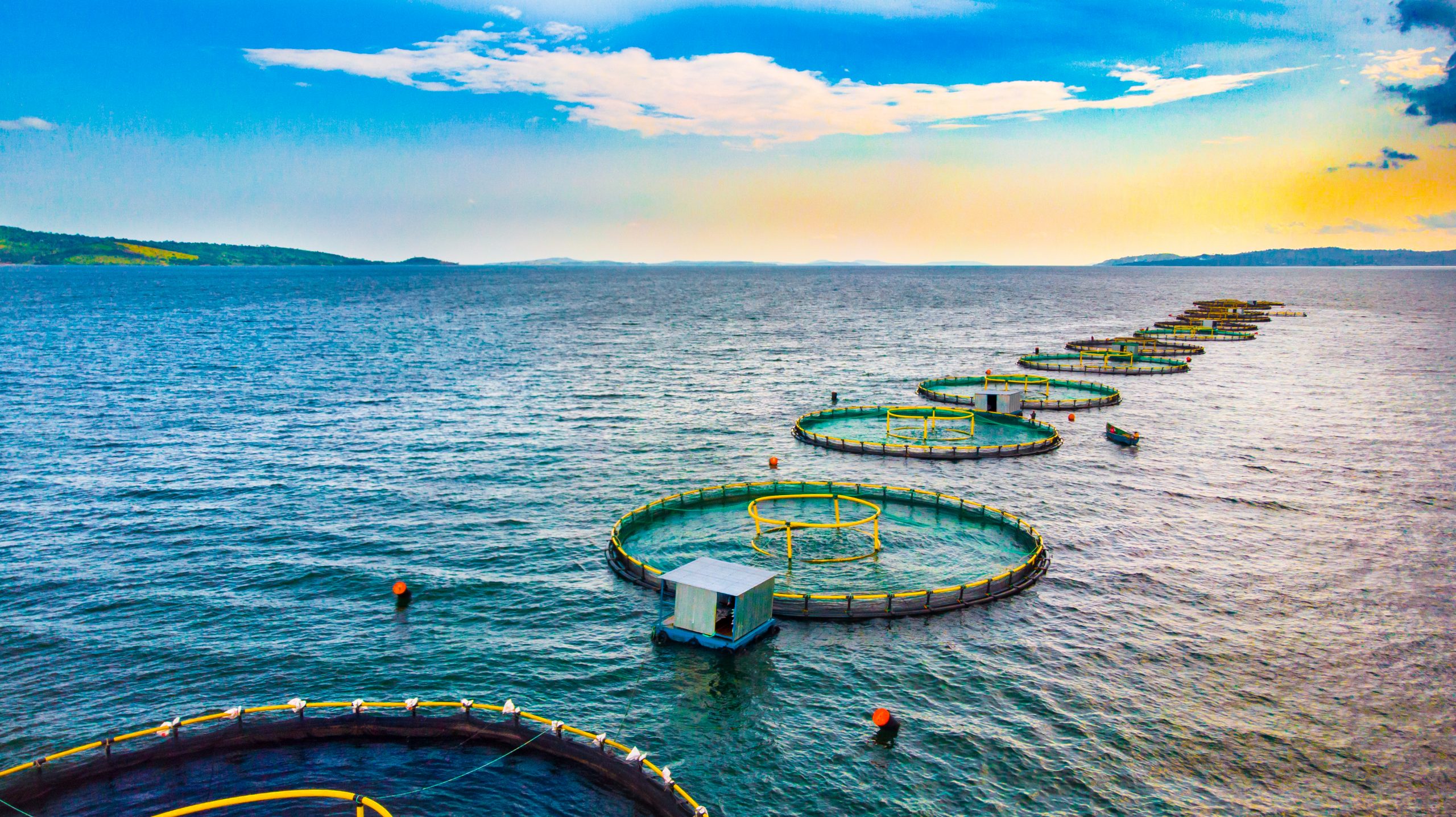African fish farming sector set for expansion as protein demand surges
Fish consumption in Africa expected to jump three folds by 2050
By Jaco Maritz
 Photo credit: Que Boxi
Photo credit: Que Boxi
Africa consumes 10m tonnes of fish every year. By 2050 it is projected to surge to 29m.[1] As the African population grows so does its demand for protein.[2] Fish is one of the most readily available cost-effective source of animal protein. But controlled aquaculture contributes less than 10% to the total fish supply in Africa. Most catches are wild. But overfishing has decimated fish stocks in the continent. Sierra Leone, for example, loses an estimated US$29m to illegal fishing each year. That means captive fish farming is essential to meet future demand.
According to Fadoua Boudiba, Africa lead at Dutch-based aquaculture investment firm Aqua-Spark, 40% of the fish consumed in Africa is imported, even though the continent has sufficient resources to support domestic production. Nigeria faces a deficit of about 2.4m tonnes of fish per annum, while Kenya’s deficit exceeds 300,000 tonnes.[3] [4]
Tilapia on the menu
One of the most popular farmed fish species in Africa is tilapia - widely recognised as a healthy, sustainable, and affordable source of nutrients. This resilient fish thrives in a variety of environments, including lakes, rivers, ponds, and closed systems. Africa and tilapia have a long history together: tilapia is featured in ancient Egyptian mythology dating back to 3,000 BCE. Many tilapia species are indigenous to rivers and lakes in sub-Saharan Africa.
Traditionally the tilapia was traditionally caught wild, after it started to get bred in farms during the colonial era, it became a captive fish farming source of protein for Africans. Since 1940s tilapia farming has been conducted as a side business by small-scale farmers who also cultivated other crops. However, the early 2000s saw the emergence of more large-scale commercial producers.
Aqua-Spark, which has launched a dedicated Africa investment fund, estimates that farmed tilapia production in sub-Saharan Africa is approximately 125,000 to 150,000 tonnes annually, accounting for about 40% of all farmed fish in the region. While there are still many small to mid-sized tilapia producers, the growth of the industry is expected to be driven by large-scale, vertically integrated farming enterprises.
A prominent large-scale tilapia producer is the FirstWave Group, which farms fish in cages on Lake Kariba in Zambia and on the Ugandan side of Lake Victoria. The company markets its fish under the Yalelo brand.[5] Between its two operations, FirstWave produces approximately 15,000 to 20,000 tonnes of tilapia annually.[6] Like many large aquaculture operations in Africa, FirstWave has vertically integrated by establishing its own fish feed manufacturing unit.[7] Traditionally, much of the fish feed used on the continent was imported from Europe or Latin America. However, these feeds are typically expensive and not specifically developed for local conditions. FirstWave not only produces feed for its own use but also sells it to other farmers.
 Photo credit: Yalelo
Photo credit: Yalelo
Another company capitalising on the tilapia opportunity is Victory Farms, which cultivates its fish in Lake Victoria, Kenya. It was founded in 2014 by Joseph Rehmann and Steve Moran. Having previously worked on an aquaculture project in Ghana, the founders recognised the substantial yet unmet demand for fish in East Africa. At the time, this deficit was being filled by fish sourced from China, but the quality was questionable. They aimed to produce high-quality tilapia to supply throughout Kenya and eventually expand to other East African countries.
Initially, the co-founders were told that Lake Victoria was not suitable for aquaculture due to its high nutrient content, shallowness, and cool temperatures. However, after conducting comprehensive technical and commercial feasibility studies, they concluded that Africa's largest lake was, in fact, ideal for tilapia farming. Victory Farms maintains approximately 30m fish at any given time and sells about 2m tilapia each month. To highlight the pent-up demand, fish consumption increased four-fold in the western Kenyan town of Rongo after Victory Farms started supplying there.
According to the company, the feed conversion ratio of tilapia – the amount of feed required to produce a unit of fish or meat – is five times more efficient than that of beef. However, the affordability of tilapia greatly depends on the farmer's production techniques. Overall, production costs in sub-Saharan Africa remain significantly higher than in Asia or South America.
Victory Farms is advancing toward precision fish farming with an automated drone system designed to forecast fish performance. The company has stated it is seeking a partnership with an aquaculture research firm to deploy drones that will monitor fish ponds. According to Rehmann, this initiative will enable the company to assess the health of the fish by analysing the colour of the water. This data could then be used to adjust feed or oxygen levels.
Catfish: Growth potential beyond Nigeria
Another farmed fish species with growth potential in Africa is catfish. Currently, catfish consumption is predominantly concentrated in Nigeria, where it is a popular delicacy.[8] In most other sub-Saharan African countries there is a lack of consumer familiarity with the species. Remarkably, Nigeria alone produces about 150,000 tonnes of catfish per year, a volume comparable to the entire tilapia production of sub-Saharan Africa combined.
Once past the fingerling (young fish ready for rearing) stage, catfish can live in a variety of conditions. The species is less susceptible to viral diseases and can even survive out of water as long as their skin remains moist.
The catfish industry in Nigeria consists mainly of small- to medium-sized farms. A notable example is entrepreneur Femi Eniola, who identified a market opportunity and founded the Osky Catfish Hatchery Grow-out & Processing Facility in Ondo State, southern Nigeria, in 2018.[9] From the outset, Eniola recognised the importance of controlling the entire value chain, from hatching catfish eggs to smoking and other processing activities. He also added a feed mill that utilises locally available ingredients such as maize, soya cake, fishmeal, and rice. Eniola has cited difficulties in securing bank financing for aquaculture projects and a shortage of skilled labour as major challenges he faces. The practice of catfish farming is also gaining traction in other African countries, including Ghana and Uganda. Aqua-Spark anticipates that it is only a matter of time before a broader catfish industry develops in these countries and beyond.
From farm to market: Distribution dynamics
“The market for locally farmed tilapia is there and will grow tremendously … But it doesn’t just come to your lap. You’ve got to go … and get it,” says Mark Amechi, owner of Ghana-based tilapia producer Tropo Farms. His statement underscores that success in Africa’s aquaculture industry is not just about production; it also requires savvy distribution and retail strategies.
Most farmed tilapia in sub-Saharan Africa are sold fresh by farmers. The fish then ends up in markets, where it is primarily deep-fried or grilled before being offered to consumers. In Western Africa, local processors also dry, salt, and smoke the fish.
Investment firm Aqua-Spark notes that while sales of tilapia currently rely on traditional marketing channels and a network of dedicated fish shops, future strategies will incorporate more innovative delivery models, including online business-to-business (B2B) and business-to-consumer (B2C) platforms. Even when consumers have access to farmed tilapia, they must be convinced of its health benefits, taste, and sustainability to make a purchase. Therefore, marketing – both online and offline – is essential.
Like several other large-scale tilapia producers, Victory Farms has developed its own sales and distribution network. The company previously encountered challenges with external logistics providers who would turn off the truck refrigerators to save fuel, which compromised the quality of its fish. To address this, the company now operates its own fleet of trucks. Victory Farms also has over 65 branded retail outlets across Kenya, primarily serving market traders who cook and sell the fish on the same day. None of these outlets have ice or refrigeration equipment; all fish is sold within one day. To ensure no loss due to spoilage, Victory Farms maintains a comprehensive dataset on each market trader to predict daily sales volumes. Market traders place orders and report sales via an SMS platform. The firm claims it can accurately forecast how much fish to stock. “Our wastage is below 1%,” explains CEO Rehmann
Most of produce (90%) coming out of Victory Farms is sold to traders. The rest is supplied to hotels and restaurants. Rehmann mentions that while the company may eventually explore supplying Kenyan supermarkets, the current focus is on the mass market.
Lake Harvest, which cultivates tilapia in floating cages along the shores of Lake Kariba in both Zimbabwe and Zambia, as well as on the Ugandan side of Lake Victoria, started by exporting fresh tilapia filets to Europe more than two decades ago. However, some years later, challenges such as reduced flight frequency between Zimbabwe and Europe, coupled with growing production volumes, prompted Lake Harvest to reorient its focus towards regional markets. Today, the company operates its own depots and retail outlets throughout Southern and East Africa. However, investing in cold-chain logistics and distribution networks is expensive, necessitating high product volumes to recover costs. Consequently, Lake Harvest partnered with the Zimbabwean livestock and agriculture business, Surrey Group, to also sell other animal proteins, such as poultry.Platinum Fisheries - located on the outskirts of the Nigerian commercial hub Lagos - is a producer of catfish, tilapia, mackerel, and snails. It has shifted its sales strategy to focus on B2B clients.[10] These include hotels, restaurants, and distributors who supply fish processing factories and public seafood markets. The pivot, initiated by founder Dupe Killa-Kafidipe, was based on the realisation that selling in larger quantities to businesses could be more profitable than direct consumer sales. Selling to B2B clients offers the advantage of receiving advance payments, which ensures a stable cash flow for the company. Despite this B2B focus, Killa-Kafidipe is considering a return to the consumer market by introducing branded processed fish products, which promise higher margins.
There also exists opportunities for African aquaculture producers to export their produce to other African countries, especially with the rollout of the African Continental Free Trade Agreement (AfCFTA).[11] Last year, the World Economic Forum (WEF) forecasted that the successful implementation of the AfCFTA would create promising opportunities in the agriculture and agro-processing sectors, specifically within the fish and meat industries. As income levels in Africa increase, both sectors are anticipated to witness a rise in overall demand, paving the way for scaled production and expanded trade in processed goods. “Demand for fish has outpaced local supply, growing at around 4% annually for the past decade, and meat consumption is also on the rise,” stated the WEF. The study also highlights opportunities to address the sector’s needs for inputs such as fish feed.
For certain products like dried catfish, there is a substantial international market, particularly among Africans living in the diaspora. Eniola from Osky Catfish, which already exports its products, highlights its popularity: “Catfish has a huge market in Asia, and also in Western countries like the United States and Canada where a lot of consumers are moving away from red meat and beginning to look to alternative protein sources.”
The USAID-funded West Africa Trade and Investment Hub has also recognised an opportunity to export canned catfish to the US, specifically targeting West Africans residing in America.[12] This potential is amplified by the African Growth and Opportunity Act, which provides eligible sub-Saharan African (SSA) nations with duty-free access to the American market, facilitating easier entry for such products.
Beyond fish
Aqua-Spark’s Boudiba notes that while aquaculture is often associated solely with fish, her firm has broadened its focus to include other aquatic species, including seaweed, sea cucumber, and shrimp. The firm has backed Madagascar-based Indian Ocean Trepang (IOT), which specialises in the cultivation of sandfish or Holothuria scabra, a type of sea cucumber.[13] This delicacy is especially favoured by Chinese communities globally. The company’s primary markets include China, Singapore, Taiwan, South Korea, North America, and Europe. IOT operates a solar-powered hatchery for sea cucumbers year-round. After approximately 18 months of growth, the adult sea cucumbers are harvested and processed into ‘trepang’, the dried form of the sea cucumber. The trepangs are sold in dry markets and are also available rehydrated, frozen, and ready-to-cook in modern trade outlets. Additionally, a portion of IOT’s production is subcontracted to local fishermen, providing them access to a profitable global market. Sandfish is one of the most threatened tropical sea cucumbers because of its high price, reaching up to US$1,800/kg when processed and dried into trepang.[14]
 Photo credit: Aqua Spark
Photo credit: Aqua Spark
Additionally, there are promising prospects in areas such as fish feed as well as logistics and distribution. Singapore-based agribusiness company Olam Agri has an aqua feed plant in Kwara State in Nigeria which produces over 100,000m2 tonnes of feed annually. Boudiba also highlights potential in alternative fish feed ingredients like black soldier fly larvae, as well as online B2B and B2C marketplaces for fish and farming inputs. In this context, towards the end of last year, Aqua-Spark led a $1.7m investment round in Aquarech, a Kenyan mobile app platform that enables manufacturers, farmers, and buyers to trade, purchase, and sell quality fish feed and fingerlings. The company also extends support to small-scale fish farmers by offering training on best fishing practices and providing financing options for feed purchases. Boudiba emphasises that the quality of the fish produced by farmers heavily relies on the quality of the feed. She notes that although Kenya has several government programmes that offer fish feed subsidies, their effectiveness is limited without proper education for farmers on best practices.
Another reason Aqua-Spark is drawn to tech-enabled companies such as Aquarech is because of their ability to collect industry data. Access to accurate, reliable data is one of the most difficult challenges of the aquaculture industry. “It is a very precious information,” Boudiba said.
Conclusion
East Africa is estimated to have a fish supply deficit of 1m tonnes. In its corporate statement Victory Farm said the gap is “one of the greatest supply-demand imbalances in the global food system today” in a statement last year while announcing it had attracted US$35m in new investment to expand operations across the region.[15]
As Africa's population increases, so too will the demand for protein, creating substantial business opportunities across the aquaculture value chain. Entrepreneurs and investors can capitalise on this by establishing new aquaculture farms, which need not be limited to fish but can also extend to products like sea cucumber and seaweed. With fish farming costs in Africa still high compared to other regions, there are prospects to introduce more efficient production techniques. Another major gap lies in producing quality and affordable fish feed, made not just from conventional sources but also from alternative ingredients such as insects. Additionally, there are opportunities for supplying equipment – from aeration systems and feeders to water quality monitors and cages – used throughout the fish farming process. Furthermore, there is potential for greater technology adoption in the sector to transform it into a digitised, data-driven industry.
References
[1] ‘Introduction to tilapia in sub-Saharan Africa’, Aqua-Spark, September 2021
[ii2‘Africa Population (LIVE)’, Worldometers, Accessed 17 April 2024
[3] ‘China fish imports hit Sh2bn, controls 83pc of market’, Business Daily, 06 September 2022
[4] ‘Catfish in Nigeria: we set about finding ways of making it more appealing’, The Conversation, 30 March 2023
[5] ‘Capitalising on opportunities in Africa’s fish farming industry’, How we made it in Africa, 19 August 2021
[6] 'Aqua Insights report and blog series starts with tilapia in Sub-Saharan Africa', Aqua-Spark, June 2021
[7] ‘About us’, FirstWave Group, Accessed 18 April 2024
[8] ‘African Catfish (Clarias gariepinus)’, Aqua-Spark, October 2021
[9] ‘Nigeria: How this entrepreneur set up a dried catfish business’, How we made it in Africa, 28 December 2021
[10] ‘Nigeria: Entrepreneur taps into the country’s vast demand for fish’, How we made it in Africa, 26 July 2023
[11] ‘AfCFTA: A new era for global business and investment in Africa’, World Economic Forum, 18 January 2023
[12] ‘From canned catfish to high-end fashion: West African products that are in high demand in the United States’, How we made it in Africa, 03 March 2021
[13] ‘From hatchery to plate’, Indian Ocean Trepang, Accessed 18 April 2024
[14] ‘Demand for sea cucumbers turns India-Sri Lanka waters into trafficking hotspot’, Mongabay, 07 February 2022
[15] ‘Fish in East Africa: Among world’s greatest food supply-demand imbalances’, How we made it in Africa, 18 April 2023














/enri-thumbnails/careeropportunities1f0caf1c-a12d-479c-be7c-3c04e085c617.tmb-mega-menu.jpg?Culture=en&sfvrsn=d7261e3b_1)

/cradle-thumbnails/research-capabilities1516d0ba63aa44f0b4ee77a8c05263b2.tmb-mega-menu.jpg?Culture=en&sfvrsn=1bc94f8_1)







